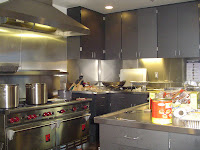Every Writer Should Visit a Fire Station

 Because the community was very active in furnishing the firehouse, there was quite a turnout of people for the opening ceremonies. Afterwards, they had hotdogs and potato chips and cake for the kids and the 'big kids'.
Because the community was very active in furnishing the firehouse, there was quite a turnout of people for the opening ceremonies. Afterwards, they had hotdogs and potato chips and cake for the kids and the 'big kids'. In our urbanized, highly industrialized, highly technical and electronic society, we don't think about how extensive a variety of fires we can have and how much specialized education might go into combating each of them. We just expect our firemen to take care of them.
In our urbanized, highly industrialized, highly technical and electronic society, we don't think about how extensive a variety of fires we can have and how much specialized education might go into combating each of them. We just expect our firemen to take care of them. For example, there is the Foam Tender Squad, the Hazardous Materials Squad, the Heavy Apparatus Unit (which has things like The Jaws of Life), the EMS Cars, the Swift Water Rescue with its very neat little boats, and the Bike Squad. These are some of the special units which were on display in the yard.
For example, there is the Foam Tender Squad, the Hazardous Materials Squad, the Heavy Apparatus Unit (which has things like The Jaws of Life), the EMS Cars, the Swift Water Rescue with its very neat little boats, and the Bike Squad. These are some of the special units which were on display in the yard. Firemen have to go through a year or two on regular shifts before they can apply for training on their special interests.
The cute green vehicle above is called a Medi-Bed unit. It has a gurney on it. I'm not quite sure what it might be used for, unless it's a way to bring another gurney into play to transport victims who might not need the facilities of a full-fledged ambulence on the way to the hospital.
I talked with the guys from the Hazardous Materials Squad about their specialized training.
One doesn't stop to think about it, but you can't go in and stop a chemical spill or fire without understanding the chemistry behind the materials you are facing -- what reacts with what, what will neutralize the situation, what will exasperate it, what will make the situation even more toxic, what will require evacuation, etc.
 When these guys come onto a scene, we expect them to know all this, but I know that I've never stopped to think about how much more learning they must have than the guy who holds a hose or someone like me, for that matter.
When these guys come onto a scene, we expect them to know all this, but I know that I've never stopped to think about how much more learning they must have than the guy who holds a hose or someone like me, for that matter. The event that I stood as a bystander for was the high dive into a mat off the roof of the firehouse that a firefighter geared up to do. There was no way I could miss such an awesome event.
The event that I stood as a bystander for was the high dive into a mat off the roof of the firehouse that a firefighter geared up to do. There was no way I could miss such an awesome event.And it was fascinating. First, the firemen on the ground brought in a rolled up large plastic bundle which they laid out flat on the ground. I didn't think to ask how long it might be but it was huge -- maybe 10 to 20 feet?
 Then they brought out two free standing fans, the kind you set on your living room floor if you don't have air-conditioning. Connected to the mat were these plastic tubes, which for lack of a correct name for them, I'll call the mat legs. It was these legs which the firemen attached to these fans to inflate the mat. As you can see from the picture to the right, the legs are pretty good size themselves.
Then they brought out two free standing fans, the kind you set on your living room floor if you don't have air-conditioning. Connected to the mat were these plastic tubes, which for lack of a correct name for them, I'll call the mat legs. It was these legs which the firemen attached to these fans to inflate the mat. As you can see from the picture to the right, the legs are pretty good size themselves. When the mat was fully inflated, it stood higher than I did, which meant that I couldn't see the top surface of the mat. This, of course, meant that I also couldn't see the firefighter either when he bounced into it.
When the mat was fully inflated, it stood higher than I did, which meant that I couldn't see the top surface of the mat. This, of course, meant that I also couldn't see the firefighter either when he bounced into it.In the picture to the left, you can see a fireman holding a rope fairly taut. There were firemen stationed at each end and in the middle of the sides, also holding onto ropes. With these ropes, they held the mat steady and in place. Otherwise, the wind could cause it to move. I had never before realized how big these mats are, but they would have to be to buffer a fall from a high building. Still this looked far more dangerous than I ever want to be involved with.
 And then the firefighter on the roof did his dive. I held my camera at ready, hoping to capture it, but between my brain acknowledging that he was falling, my finger depressing the button and the shutter opening, his flight was too quick for me to capture a picture. All I got was the shadow you see here.
And then the firefighter on the roof did his dive. I held my camera at ready, hoping to capture it, but between my brain acknowledging that he was falling, my finger depressing the button and the shutter opening, his flight was too quick for me to capture a picture. All I got was the shadow you see here.  But it was quite a spectacular feat and to know that this might be the only way to have your life saved some day... it was awesome.
But it was quite a spectacular feat and to know that this might be the only way to have your life saved some day... it was awesome.What I was most interested in was the promised tour of the firestation. Except there turned out to be no official tours. When I asked about them, they told me to just walk around the first floor. The second floor was off limits because that was the firemen's private quarters. You can just imagine how disappointed the writer in me was.
 I must have looked like a poor waif to be pitied because the fire captain offered to show me around himself. I couldn't ask for a better guide.
I must have looked like a poor waif to be pitied because the fire captain offered to show me around himself. I couldn't ask for a better guide.The Day Room is where the firemen relax when on duty and they had a nice large TV hanging on the wall inside it. He pointed out the platform which the guys built themselves so that they had their version of stadium seating. It was so nicely done and carpetted that one would think it was part of the original design.
There's a gym where they can work out and that had a small portable TV in it. Since we weren't allowed upstairs, and being with the captain didn't earn me any special privileges to go touring up there, I did manage to wangle a description out of him, for writing purposes. Apparently they have the upstairs partitioned off for the guys and two beds in each partition.
 The kitchen is huge and would be the envy of any Suzy Homemaker, but each shift has to bring in their own food and prepare it. Each shift is on for 24-hours and then they rotate off. So the first thing they do is decide what they want to eat and collect the money to go shopping. Remember how you see firemen in the groceries while you shop? While one always figures they are shopping for the firestation, I didn't know that they do this every day because they are shopping for their own shifts, using their own money.
The kitchen is huge and would be the envy of any Suzy Homemaker, but each shift has to bring in their own food and prepare it. Each shift is on for 24-hours and then they rotate off. So the first thing they do is decide what they want to eat and collect the money to go shopping. Remember how you see firemen in the groceries while you shop? While one always figures they are shopping for the firestation, I didn't know that they do this every day because they are shopping for their own shifts, using their own money.The chairs for the opening ceremonies were set up in the area where the fire trucks would actually be housed, so on the other side of that was the Laundry and the Turnout Room.
 Next to the laundry room is what's called the Turnout Room and this is where their heavy fire jackets hang on racks and their helmets and body gear is stashed. In a fire alarm, it seems that those inside the fire station will have to run around the trucks to get to the Turnout Room, but once they get their gear, it's a straight shot into the big fire engines.
Next to the laundry room is what's called the Turnout Room and this is where their heavy fire jackets hang on racks and their helmets and body gear is stashed. In a fire alarm, it seems that those inside the fire station will have to run around the trucks to get to the Turnout Room, but once they get their gear, it's a straight shot into the big fire engines.Labels: Fire Station #78, firemen, writing



0 Comments:
Post a Comment
<< Home